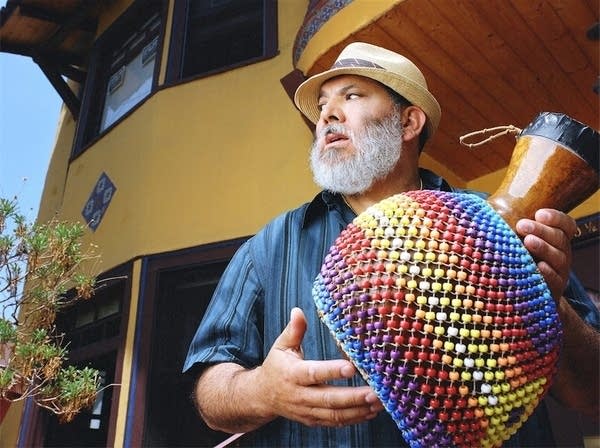Latin jazz bandleader Poncho Sanchez says 'Don't just listen - Dance! '
Go Deeper.
Create an account or log in to save stories.
Like this?
Thanks for liking this story! We have added it to a list of your favorite stories.

A frequent criticism of modern jazz is that it has lost its way, distanced from popular audiences who want to move to the music. But Latin jazz still lures dancers to the floor with Afro-Cuban and other rhythms.
Bandleader Poncho Sanchez brings that soulful blend to the Ordway Center for the Performing Arts tonight. Anyone going to the concert should know that he bandleader doesn't want his audience to sit still. He fully expects you to move. After all, his shows are a party.
"When I get to a concert or to a gig I tell them, 'I didn't come here to have a bad time; I came here to have a good time!' " Sanchez said from California. "So that's what we do."
Sanchez plays congas and for nearly four decades, Latin jazz fans have responded to his call. He became a big name after joining vibe player Cal Tjader's band in the 1970s. Still inspired by his mentor, Sanchez, 60, is among those keeping the music alive.
Turn Up Your Support
MPR News helps you turn down the noise and build shared understanding. Turn up your support for this public resource and keep trusted journalism accessible to all.
After Tjader died in 1982, Sanchez launched a solo career. Since then, he has become a standard bearer for Latin jazz, playing a fusion of various genres with roots in Havana and New York City.
"You have the sophistication of American writing, American standards, American tunes, and then you have the flavor of the Latin rhythms — the mambo, the cha-cha-cha, the guaguanco — all the Latin rhythms, all the Latin percussion instruments that come from Latin America," Sanchez said. "You put those two idioms together and you have Latin jazz."
The big moment in Latin jazz came in the early '40s, when Dizzy Gillespie first worked with Cuban conga player Chano Pozo. On "Chano y Dizzy!" released last year by Concord Music, Sanchez and New Orleans trumpeter Terrance Blanchard pay tribute to the two greats with 11 tunes that are sure to be part of the bandleader's Minnesota show.

Among the recording's classic numbers is a medley of "Tin Tin Deo," "Manteca" and Guachi Guaro." It also includes the Gillespie tunes "Con Alma" and "Groovin' High."
Although Cuba had a thriving big band tradition that rivaled New York City's, Sanchez said two musicians fused Afro-Cuban and North American jazz rhythms in a way that had never been done before.
"It started back in this country back then with those two guys," he said. "That's why I always give them credit for kind of inventing Latin jazz."
Cuba also had a thriving dance music tradition back then, as it does today. Born in Laredo, Texas, Sanchez became hooked on the music after his Mexican-American family moved to Los Angeles in the 1950s.
"The minute we got here my brothers and sisters discovered it," recalled Sanchez, the youngest of 11. "They caught the first wave of the mambo and cha-cha-cha music that came to Los Angeles by way of New York City, Cuba and Puerto Rico, even through Mexico City," he recalled. "So I grew up with this music."
He first learned to play the guitar. But in high school, he switched to drums, timbales and congas, teaching himself by playing along with records of great bandleaders. Later, after watching those bands play on stage, he practiced in his mother's garage.
"I used to go to the old Lighthouse in Hermosa Beach and see Willie Bobo's band play," he said. "Mongo Santamaria I've seen play there. I've seen Cal Tjader's band play there, the Jazz Crusaders, Freddy Hubbard. I mean, it was great. "

Sanchez also was raised on soul music. He counts as favorites Wilson Pickett, Otis Redding, and of course, James Brown.
His Ordway show promises to be a mix of Latin jazz, Latin soul and salsa, a combination he says will make it hard to sit still.
"We use those different rhythms in our show," he said. "I mean, we do do shows in theaters or auditoriums where you're not really supposed to dance. It's a show, so you sit down and watch the show. But like 99 percent of the time, by the end of the show people are dancing in the aisles. So if you feel it, just get up and get into it."
If Sanchez knows his audience, they'll hit the dance floor near the stage.
Dear reader,
Political debates with family or friends can get heated. But what if there was a way to handle them better?
You can learn how to have civil political conversations with our new e-book!
Download our free e-book, Talking Sense: Have Hard Political Conversations, Better, and learn how to talk without the tension.




